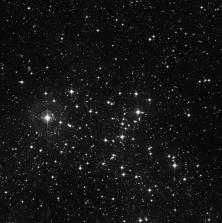M6 or NGC 6405 is one of two bright naked-eye open star clusters in the south-eastern portion of the constellation of Scorpius, which I have termed both as Scorpio’s Sisters. The companion open cluster is M7 or NGC 6475 (17536-3449), and appears on the next webpage. This open cluster of was first noted in Ptolemy’s ‘Almagest’ as a lucid spot. Edmond Halley listed it as a “nebula” No.20 in his observations from an expedition to the island of St.Helena in the South Atlantic Ocean for his ‘Southern Star Catalogue’. De Cheseaux, however, was the first to identify its stellar nature in 1745. Lacaille found it again in 1752, while Messier listed the cluster on the same night as when found for M7 on the 23rd May 1764. Flammarion described its shape as being like; “…three starry avenues leading to a large square.”
Distance is estimated to be 460pc. or 1,500 ly. (400 ly. or 1 300 pc. in AOST II), though earlier catalogues and other references give values somewhere between 490pc. to 600pc. (I.e. Sky Catalogue 2000.0 states 600 ly.) Best estimation is more likely nearer to the 500pc. mark, with the mean age of 51 million years. Some have, however, quoted, like in the IAU reference) ages between 75 and 100 million years. Stellar numbers show about eighty (80) stars between spectral classes B5 and A2, with 28 stars being brighter than 10th magnitude.
NGC 6405 contains some variables, with the brightest being the obvious yellow star BM Sco (HD 160371), which is a supergiant semi-regular or SRd type variable. This was considered for some time to be the only true giant variable known in any open star cluster. Photographic magnitudes varies between 6.8p and 8.7p in a average period of 815 days. Spectral data reveals BM Sco is a K2.5 star, whose the luminosity class has been place more recently between II and III, downgrading to a mere giant. It is likely that it is not an Ib type, as stated in Sky Catalogue 2000.0.
Its diameter is some 20′ to 25′ across, translating to a true physical size of 8 to 12 ly. By the Shapley classification it is type ‘e’, or by the Trumpler system as ‘III 2 p’. Total visual magnitude is 4.2, though later assessments place it fainter, at 5.0 to 5.6. To the naked-eye, it lies almost centrally within the Milky Way, and although this is true, the magnitude extinction is about 0.5. Within the cluster, the brightest star is 6.17 magnitude, while the second star, HD 160202 is a known flare star that was observed in 1965 to brighten by five magnitudes over the period of about twenty minutes.




